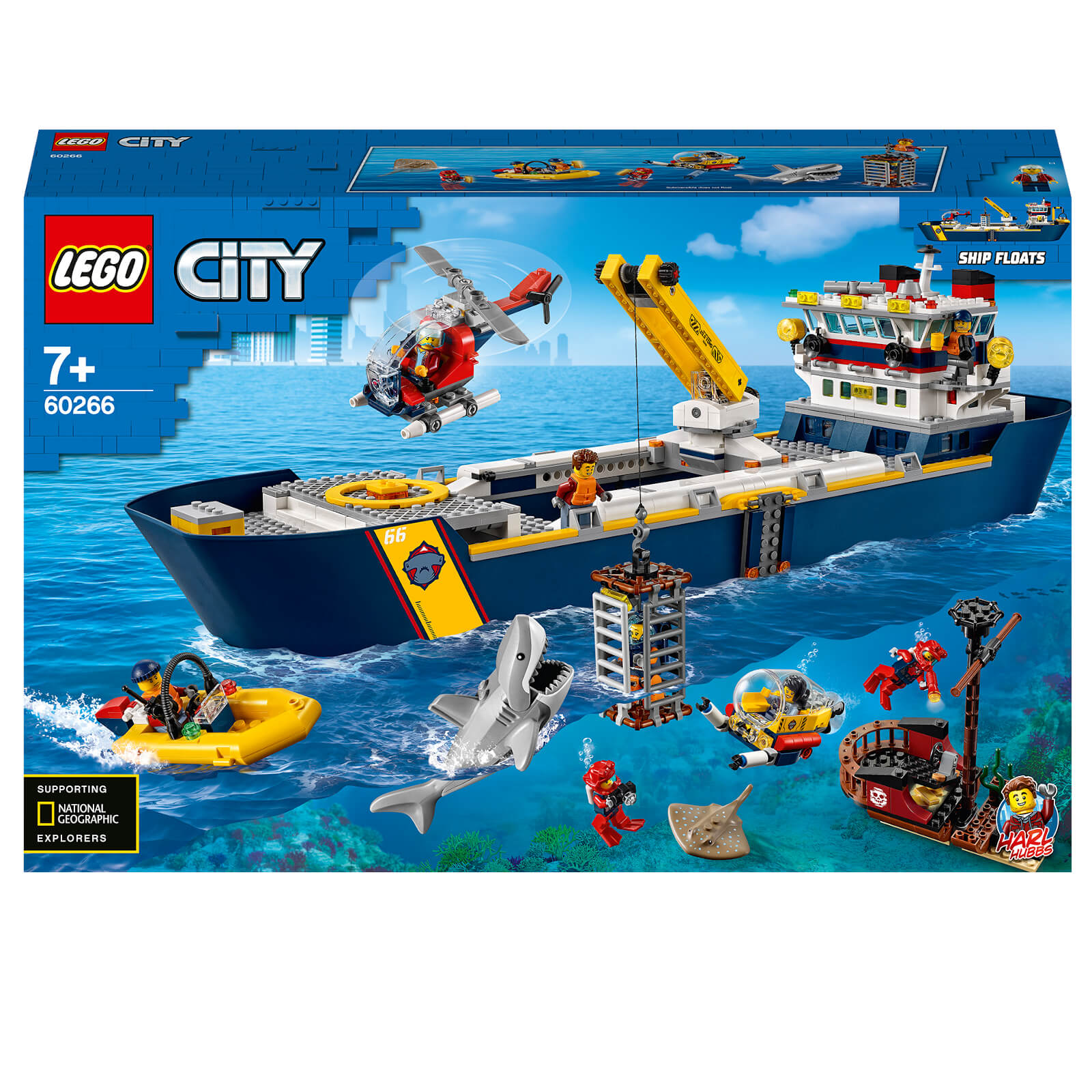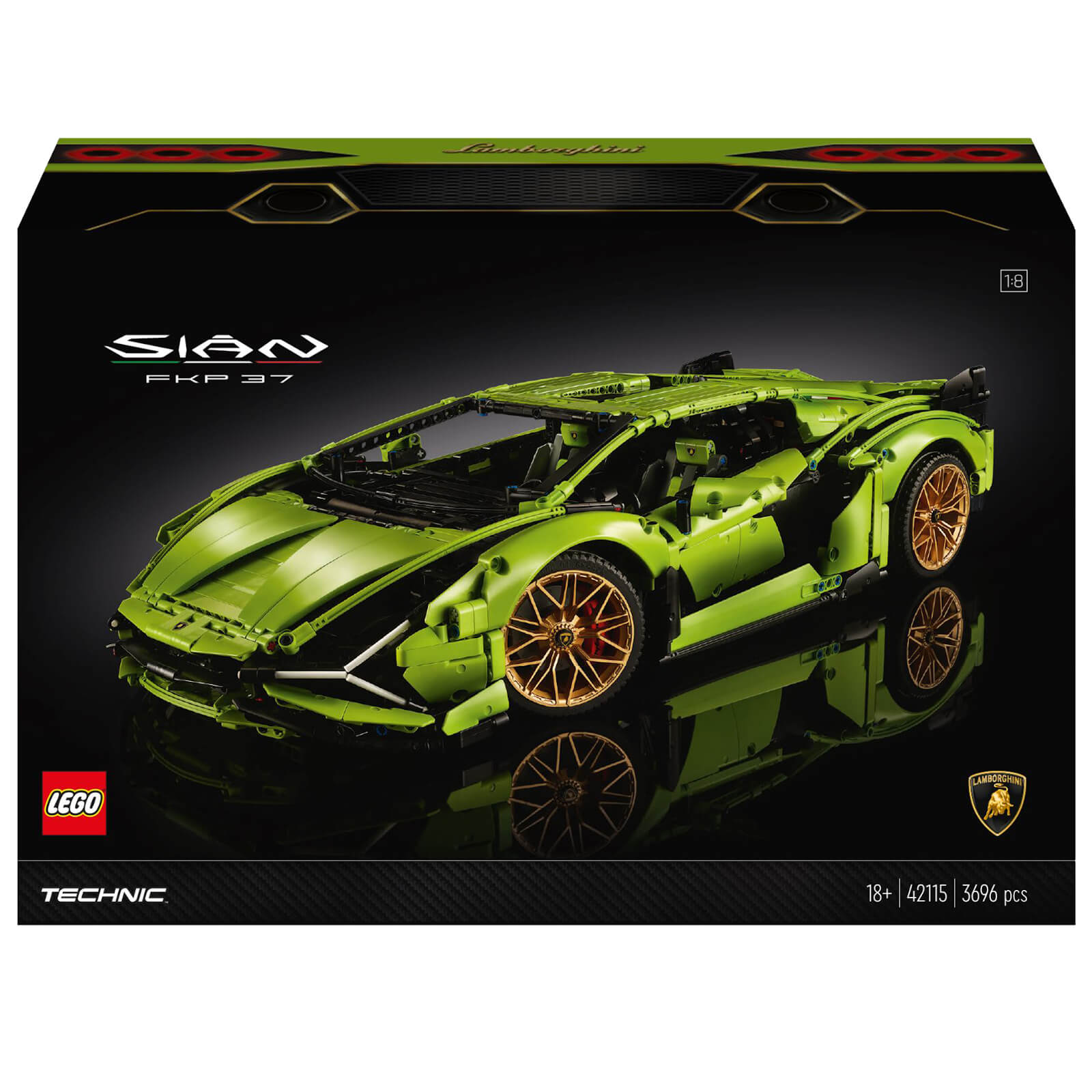LEGO City: Ocean Exploration Ship Floating Toy Boat (60266) – IWOOT UK
Toy ship that really floats on water, with accessible command cockpit and laboratory, a working crane, helipad, movable boat arm and storage. This multi-vehicle toy also includes a research submarine, helicopter, speedboat, shark cage and pirate shipwreck with hidden treasure.
This super-long ship not only floats on water, it has everything kids need for endless ocean exploration. There’s a shark cage, working crane, research submarine, helicopter and even a pirate shipwreck with hidden treasure! With 8 explorer minifigures, including LEGO City TV character Harl Hubbs, the scene is set for action-packed escapades. Fun and adventure are on the horizon with the mighty LEGO City Ocean Exploration Ship (60266).
This toy playset includes simple building instructions and Instructions PLUS – part of the free LEGO Building Instructions app for smartphones and tablets. This interactive building guide, with amazing zoom and rotate viewing tools, quickly helps budding LEGO builders become master builders.
LEGO City is proud to support the work of National Geographic Explorers. With feature-rich buildings, realistic vehicles and fun characters, our Ocean playsets deliver an exciting, open-ended world of underwater discovery and adventure for budding explorers. The toy exploration ship measures over 7″ (18cm) high, 24″ (63cm) long and 6″ (17cm) wide, while the pirate shipwreck measures over 6″ (16cm) high, 5″ (13cm) long and 3″ (8cm) wide. Contains 745 pieces.
Features:
- Toy ship that really floats on water, with accessible command cockpit and laboratory, a working crane, helipad, movable boat arm and storage
- This multi-vehicle toy also includes a research submarine, helicopter, speedboat, shark cage and pirate shipwreck with hidden treasure
- Includes a team of 8 explorers with LEGO City Adventures TV series hero Harl Hubbs minifigure, shark and stingray figures, plus accessories
- Use Instructions PLUS, available as part of the free LEGO Building Instructions app for smart devices, to zoom, rotate and visualise
- Check out other LEGO City Oceans sets: Ocean Exploration Base 60265, Ocean Exploration Submarine 60264, and Ocean Mini-Submarine 60263
- Age: 7+
- Number of Pieces: 745
Additional information
| numberPieces | 745 |
|---|---|
| Age | 7+ |
A boat is a watercraft of a large range of types and sizes, but generally smaller than a ship, which is distinguished by its larger size or capacity, its shape, or its ability to carry boats.
Small boats are typically used on inland waterways such as rivers and lakes, or in protected coastal areas. However, some boats (such as whaleboats) were intended for offshore use. In modern naval terms, a boat is a vessel small enough to be carried aboard a ship.
Boats vary in proportion and construction methods with their intended purpose, available materials, or local traditions. Canoes have been used since prehistoric times and remain in use throughout the world for transportation, fishing, and sport. Fishing boats vary widely in style partly to match local conditions. Pleasure craft used in recreational boating include ski boats, pontoon boats, and sailboats. House boats may be used for vacationing or long-term residence. Lighters are used to move cargo to and from large ships unable to get close to shore. Lifeboats have rescue and safety functions.
Boats can be propelled by manpower (e.g. rowboats and paddle boats), wind (e.g. sailboats), and inboard/outboard motors (including gasoline, diesel, and electric).
A city is a human settlement of a substantial size. The term "city" has different meanings around the world and in some places the settlement can be very small. Even where the term is limited to larger settlements, there is no universally agreed definition of the lower boundary for their size. In a narrower sense, a city can be defined as a permanent and densely populated place with administratively defined boundaries whose members work primarily on non-agricultural tasks. Cities generally have extensive systems for housing, transportation, sanitation, utilities, land use, production of goods, and communication. Their density facilitates interaction between people, government organizations, and businesses, sometimes benefiting different parties in the process, such as improving the efficiency of goods and service distribution.
Historically, city dwellers have been a small proportion of humanity overall, but following two centuries of unprecedented and rapid urbanization, more than half of the world population now lives in cities, which has had profound consequences for global sustainability. Present-day cities usually form the core of larger metropolitan areas and urban areas—creating numerous commuters traveling toward city centres for employment, entertainment, and education. However, in a world of intensifying globalization, all cities are to varying degrees also connected globally beyond these regions. This increased influence means that cities also have significant influences on global issues, such as sustainable development, climate change, and global health. Because of these major influences on global issues, the international community has prioritized investment in sustainable cities through Sustainable Development Goal 11. Due to the efficiency of transportation and the smaller land consumption, dense cities hold the potential to have a smaller ecological footprint per inhabitant than more sparsely populated areas. Therefore, compact cities are often referred to as a crucial element in fighting climate change. However, this concentration can also have some significant negative consequences, such as forming urban heat islands, concentrating pollution, and stressing water supplies and other resources.
Exploration is the process of exploring, an activity which has some expectation of discovery. Organised exploration is largely a human activity, but exploratory activity is common to most organisms capable of directed locomotion and the ability to learn, and has been described in, amongst others, social insects foraging behaviour, where feedback from returning individuals affects the activity of other members of the group.
Floating may refer to:
- a type of dental work performed on horse teeth
- use of an isolation tank
- the guitar-playing technique where chords are sustained rather than scratched
- Floating (play), by Hugh Hughes
- Floating (psychological phenomenon), slipping into altered states
- Floating exchange rate, a market-valued currency
- Floating voltage, and floating ground, a voltage or ground in an electric circuit that is not connected to the Earth or another reference voltage
- Floating point, a representation in computing of rational numbers most commonly associated with the IEEE 754 standard
- Floating (film), a 1997 American drama film
The ocean is the body of salt water that covers approximately 70.8% of Earth. In English, the term ocean also refers to any of the large bodies of water into which the world ocean is conventionally divided. The following names describe five different areas of the ocean: Pacific, Atlantic, Indian, Antarctic/Southern, and Arctic. The ocean contains 97% of Earth's water and is the primary component of Earth's hydrosphere and is thereby essential to life on Earth. The ocean influences climate and weather patterns, the carbon cycle, and the water cycle by acting as a huge heat reservoir.
Ocean scientists split the ocean into vertical and horizontal zones based on physical and biological conditions. The pelagic zone is the open ocean's water column from the surface to the ocean floor. The water column is further divided into zones based on depth and the amount of light present. The photic zone starts at the surface and is defined to be "the depth at which light intensity is only 1% of the surface value": 36 (approximately 200 m in the open ocean). This is the zone where photosynthesis can occur. In this process plants and microscopic algae (free floating phytoplankton) use light, water, carbon dioxide, and nutrients to produce organic matter. As a result, the photic zone is the most biodiverse and the source of the food supply which sustains most of the ocean ecosystem. Ocean photosynthesis also produces half of the oxygen in the Earth's atmosphere. Light can only penetrate a few hundred more meters; the rest of the deeper ocean is cold and dark (these zones are called mesopelagic and aphotic zones). The continental shelf is where the ocean meets dry land. It is more shallow, with a depth of a few hundred meters or less. Human activity often has negative impacts on marine life within the continental shelf.
Ocean temperatures depend on the amount of solar radiation reaching the ocean surface. In the tropics, surface temperatures can rise to over 30 °C (86 °F). Near the poles where sea ice forms, the temperature in equilibrium is about −2 °C (28 °F). In all parts of the ocean, deep ocean temperatures range between −2 °C (28 °F) and 5 °C (41 °F). Constant circulation of water in the ocean creates ocean currents. Those currents are caused by forces operating on the water, such as temperature and salinity differences, atmospheric circulation (wind), and the Coriolis effect. Tides create tidal currents, while wind and waves cause surface currents. The Gulf Stream, Kuroshio Current, Agulhas Current and Antarctic Circumpolar Current are all major ocean currents. Such currents transport massive amounts of water, gases, pollutants and heat to different parts of the world, and from the surface into the deep ocean. All this has impacts on the global climate system.
Ocean water contains dissolved gases, including oxygen, carbon dioxide and nitrogen. An exchange of these gases occurs at the ocean's surface. The solubility of these gases depends on the temperature and salinity of the water. The carbon dioxide concentration in the atmosphere is rising due to CO2 emissions, mainly from fossil fuel combustion. As the oceans absorb CO2 from the atmosphere, a higher concentration leads to ocean acidification (a drop in pH value).
The ocean provides many benefits to humans such as ecosystem services, access to seafood and other marine resources, and a means of transport. The ocean is known to be the habitat of over 230,000 species, but may hold considerably more – perhaps over two million species. Yet, the ocean faces many environmental threats, such as marine pollution, overfishing, and the effects of climate change. Those effects include ocean warming, ocean acidification and sea level rise. The continental shelf and coastal waters are most affected by human activity.
A ship is a large vessel that travels the world's oceans and other navigable waterways, carrying cargo or passengers, or in support of specialized missions, such as defense, research and fishing. Ships are generally distinguished from boats, based on size, shape, load capacity and purpose. Ships have supported exploration, trade, warfare, migration, colonization, and science. Ship transport is responsible for the largest portion of world commerce.
The word ship has meant, depending on the era and the context, either just a large vessel or specifically a ship-rigged sailing ship with three or more masts, each of which is square-rigged.
The earliest historical evidence of boats is found in Egypt during the 4th millennium BCE. In 2024, ships had a global cargo capacity of 2.4 billion tons, with the three largest classes being ships carrying dry bulk (43%), oil tankers (28%) and container ships (14%).
A toy or plaything is an object that is used primarily to provide entertainment. Simple examples include toy blocks, board games, and dolls. Toys are often designed for use by children, although many are designed specifically for adults and pets. Toys can provide utilitarian benefits, including physical exercise, cultural awareness, or academic education. Additionally, utilitarian objects, especially those which are no longer needed for their original purpose, can be used as toys. Examples include children building a fort with empty cereal boxes and tissue paper spools, or a toddler playing with a broken TV remote control. The term "toy" can also be used to refer to utilitarian objects purchased for enjoyment rather than need, or for expensive necessities for which a large fraction of the cost represents its ability to provide enjoyment to the owner, such as luxury cars, high-end motorcycles, gaming computers, and flagship smartphones.
Playing with toys can be an enjoyable way of training young children for life experiences. Different materials like wood, clay, paper, and plastic are used to make toys. Newer forms of toys include interactive digital entertainment and smart toys. Some toys are produced primarily as collectors' items and are intended for display only.
The origin of toys is prehistoric; dolls representing infants, animals, and soldiers, as well as representations of tools used by adults, are readily found at archaeological sites. The origin of the word "toy" is unknown, but it is believed that it was first used in the 14th century. Toys are mainly made for children. The oldest known doll toy is thought to be 4,000 years old.
Playing with toys is an important part of aging. Younger children use toys to discover their identity, help with cognition, learn cause and effect, explore relationships, become stronger physically, and practice skills needed in adulthood. Adults on occasion use toys to form and strengthen social bonds, teach, help in therapy, and to remember and reinforce lessons from their youth.
A toymaker is the name of someone who makes toys.






Reviews
There are no reviews yet.